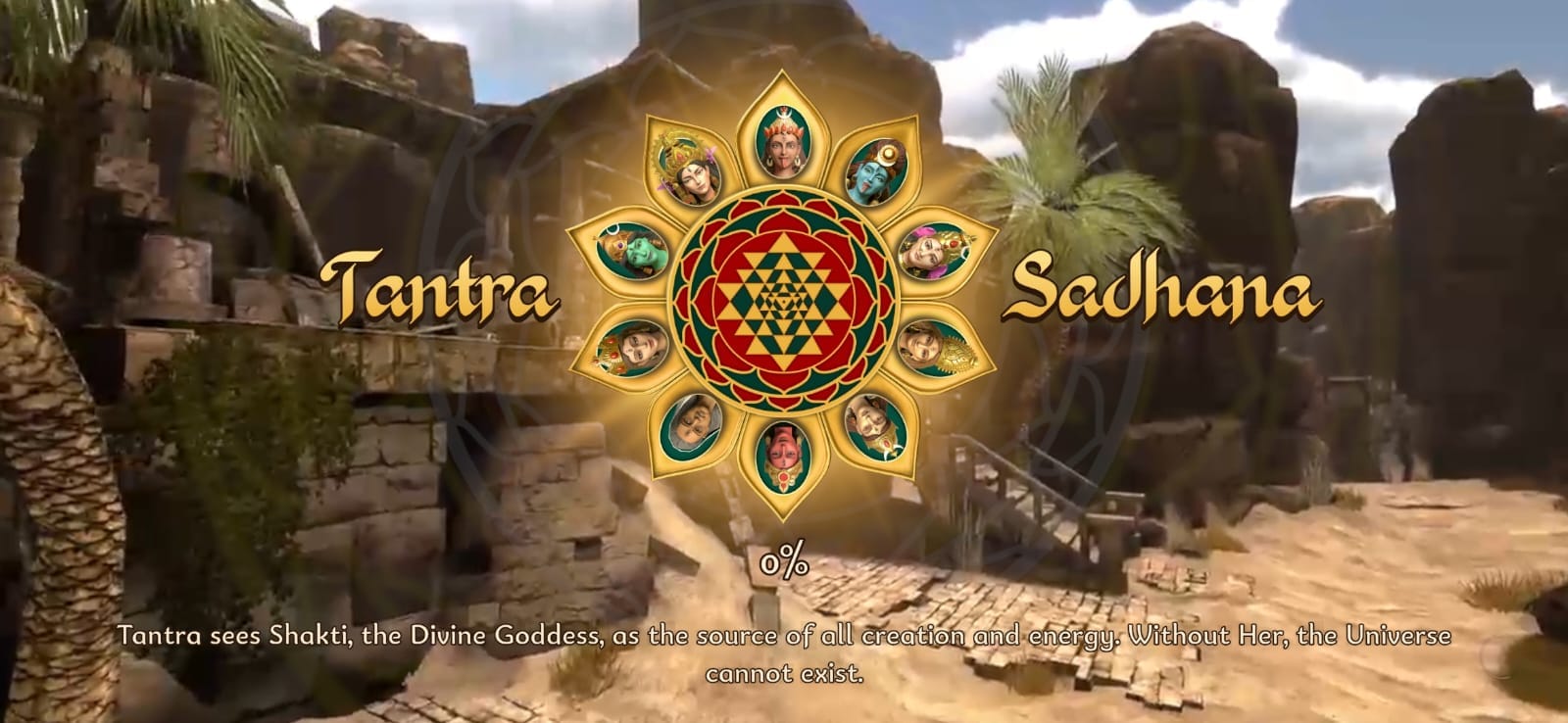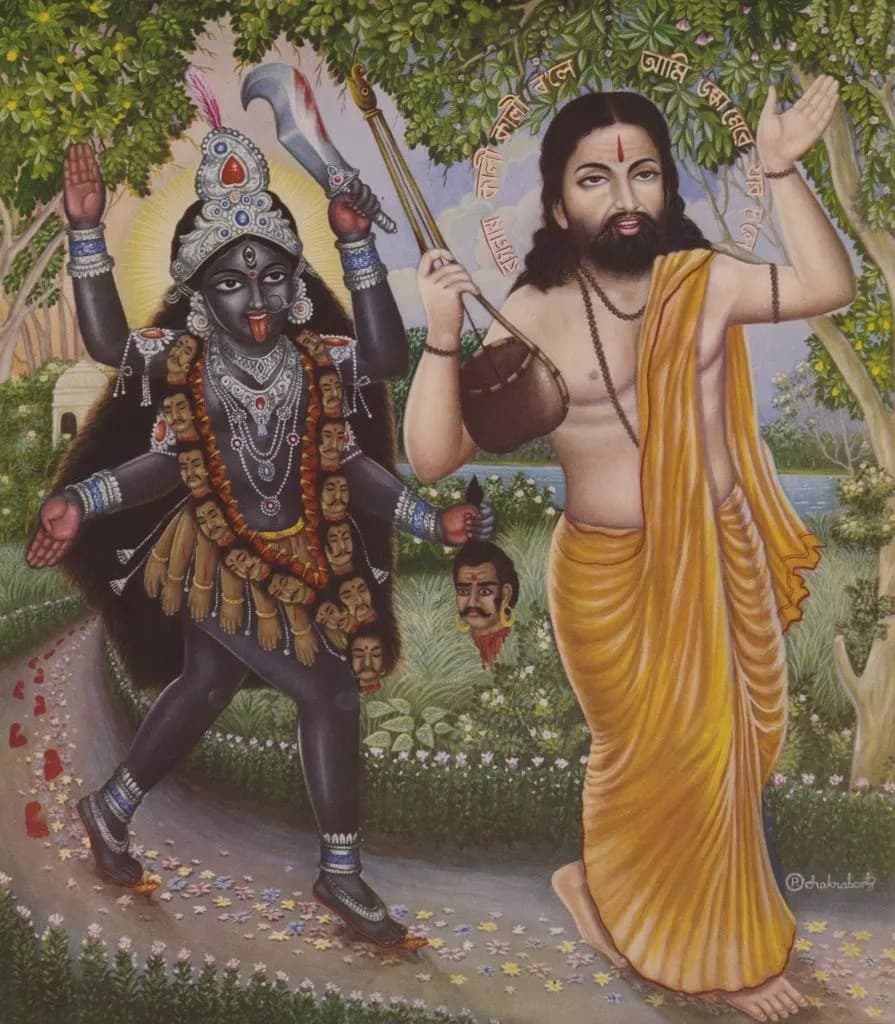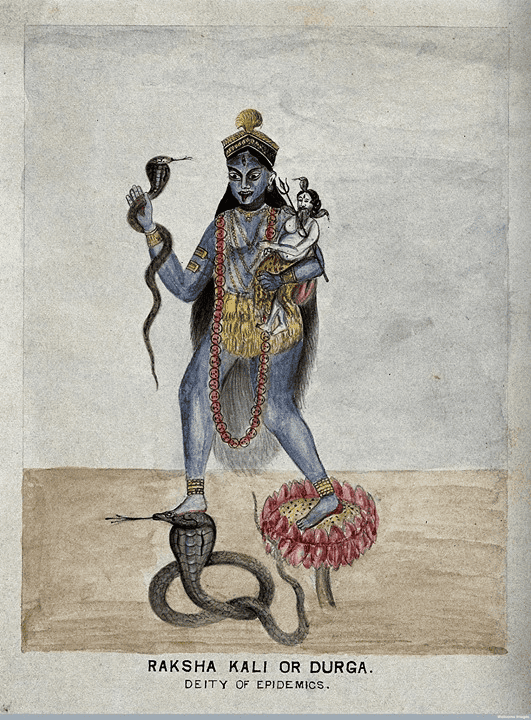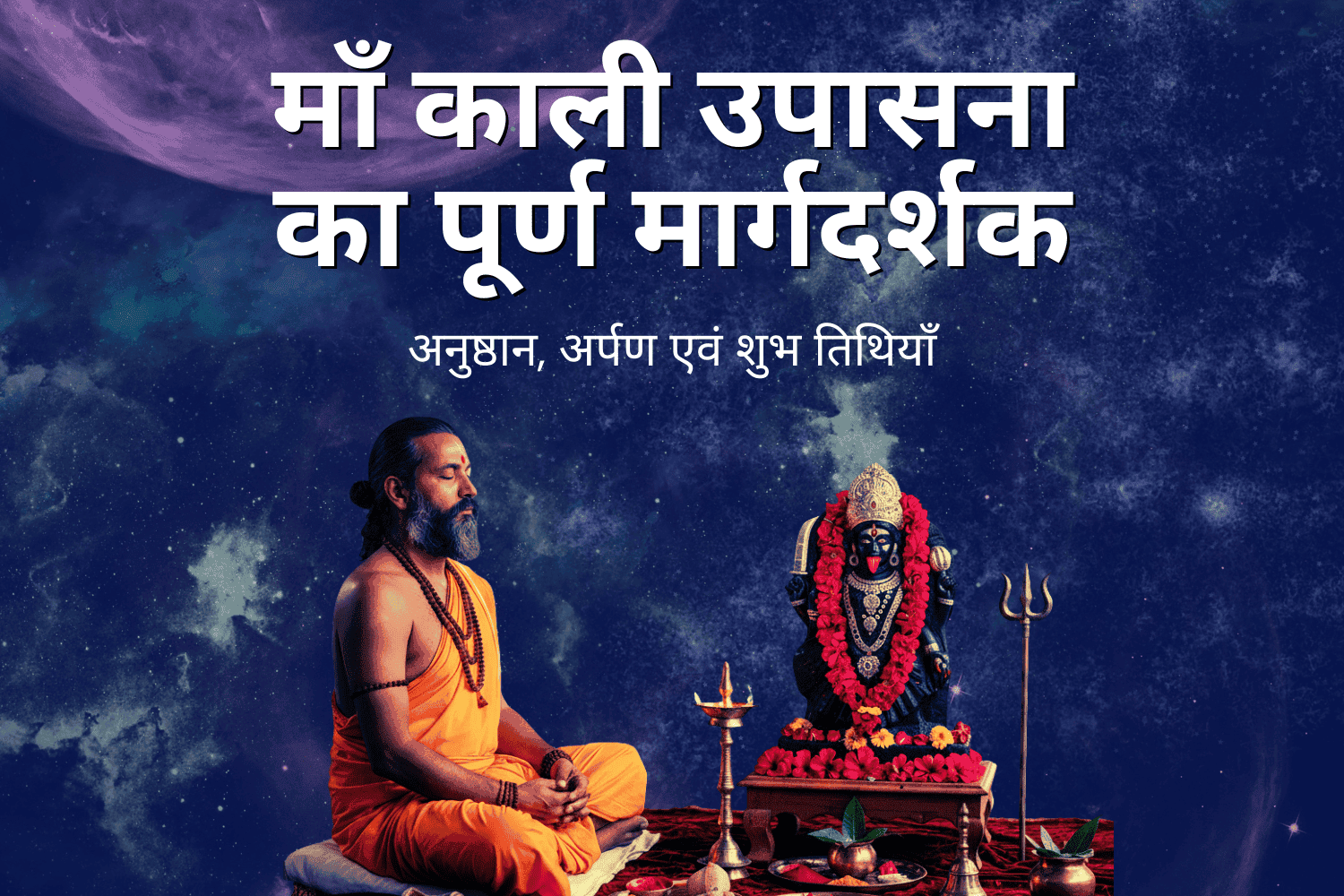In this article, you will discover:
🌑 Ma Kali’s sacred rituals in Tantra Sadhana App
🕯️ How to perform Her preliminary Puja and Shav Sadhana
🔥 Her Tantric Yagnas (fire offerings) and other Upacharas
📿 The most auspicious days & timings to connect with Her energy
🐍 Animals symbolically connected to Ma Kali
🪐 Planets linked to Her worship, and how they influence your Sadhana
Ma Kali is the first Mahavidya among the ten forms of the Divine Mother in Tantra Sadhana — the traditional spiritual discipline to worship Maa.
Kala means both darkness and time; Ma Kali consumes all our darkness into Her infinity.
She wears our karma as Her ornament, and She is beyond time.
The Tantra Sadhana app offers step-by-step guidance, drawn directly from the Vedas, to perform the Sadhana of the Das Mahavidyas.

This blog explores in detail the rituals, sacred offerings, foods, animals, and herbs used in Tantra Sadhana for the worship of Ma Kali.
It also discusses the most auspicious days and timings for Her worship, as well as the planets that represent Her energy.
Rituals To Worship Ma Kali on Tantra Sadhana App
11 Day-Preparation
Initiation & Chanting
To begin the worship of Ma Kali, the Tantra Sadhana app offers a unique 3D immersive experience set in the Smashan — the sacred cremation ground where Maa resides.
The journey is led by Master Ved Vyas, who blesses the seeker and offers guidance to walk this sacred path.
Under His instruction, the seeker is asked to solve devotional puzzles, earning the spiritual competence to be initiated into Maa’s mantra.
This leads to the Mantra Diksha, after which the seeker begins a dedicated 11-day preparation, calling out to Ma Kali using the awakened Tantric Mantra in Himalayan Siddha Om Swami’s voice.
Each day of the 11-day preparation includes:
- Chanting the Tantric Mantra 108 times, and
- Performing a Tantric Yagna (fire offering)
For this Yagna, the seeker must collect 12 specific ingredient bundles used in the ritual. These ingredients are scattered throughout the Smashan, encouraging the seeker to move through the space — deepening their connection with the cremation ground and, by extension, with Ma Kali Herself.
This daily interaction with the sacred ground builds devotion and nurtures an intimate bond between the seeker and the Goddess.
Building a Bond with Ma Kali
The journey is accompanied by the continuous chanting of the Kakaradi Kali Sahasranam Stotram by Om Swami in the background. This elevates the consciousness of the seeker and prepares them for the Yagna with devotion.
For the path of Tantra cannot be trodden without devotion.
In addition to Mantra chanting and Yagna in the Smashan, the seeker collects Symbols—stories about Ma Kali's origin and esoteric truths about Her. Walking this path, immersing the mind in Ma's stories and sacred knowledge reminds the seeker of Her omnipresence.
Over time, the seeker begins to feel Her unmistakable presence and discovers what Ma Kali uniquely means in their life.
One of Ma’s names from the Sri Lalita Sahasranam Stotram is Abhyāsātiśayajñātā — She Who is known through constant devotion. The chants and scrolls help the devotee remain in Her Bhava throughout the day and grow closer to Her.
The seeker is also accompanied by a customised dog companion—exceptionally intelligent and deeply devoted to the Mahavidya. The seeker must feed this sacred companion at least once a day.
Shav Sadhana
After 11 days of disciplined preparation, the seeker gains access to the grounds where the secret Shav Sadhana is performed.
This opens the door to a sacred 21-day practice known only to those who have been deemed ready. Under the watchful gaze of Maa Kali, the Sadhak invokes the Shav — a corpse.
The ritual is conducted while seated atop the corpse, a powerful act designed to shatter societal beliefs, religious conditioning, and personal attachments. The goal is not morbidity, but transcendence — to see Maa in everything, including what the world labels as lifeless.
Seated in the Smashan, atop the Shav, the seeker confronts the ultimate truth: that all things — bodies, relationships, fame, and identity — are impermanent.
In this confrontation, fear of death begins to dissolve. A deep Vairagya or detachment arises. The cremation ground becomes a mirror of truth, a place where one remembers that all who are born must one day return here.
In such a space, stripped of illusion, the mind quiets. The outer chaos fades, and an inner silence begins to take root — the silence where Maa speaks.
Offerings For Maa
What To Offer Maa
In the Sri Lalita Sahasranam Stotram, Maa is described as Savyapasavya-Margastha — the Goddess of both the right-handed and left-handed paths.
She is Kaulini-Kevala — worshipped by the Kaulas, Vamakeshvari — adored by the Vamacharins, and Samayachara-Tatpara — devoted to the path of Samayachara.
She is the Mother of all Tantric paths.
The text also names Her Panchayajnapriya — fond of the Five Sacrifices. She is Yajnapriya (lover of sacrifice), Yajnakartri (the doer of sacrifice), and Yajamana Svarupini (the very essence of the sacrificer).
However, She is not pleased by outer rituals alone. As Her name reveals — Antarmukha-Samaradhya, Bahirmukha Sudurlabha — She is worshipped internally and is difficult to access through external means alone.
This is where the Tantra Sadhana App becomes a digital temple — offering seekers the purest essence of inner worship to Maa Mahakali.
Offerings in the Awakened Tantric Fire Ritual on the Tantra Sadhana App
In awakened Tantric fire offerings, every substance holds deep esoteric meaning.
With each sacred name of Maa, the seeker offers consecrated ingredients into the flame — in full surrender. Every offering becomes a symbol of both inner and outer transformation.
The Sustainers of the Fire
The sacred fire is first nourished and sustained with offerings that embody life and purity:
- Ghee and Havan Samagri — a sacred blend of aromatic herbs, roots, and leaves — keep the flame alive, purify the environment, and forge the seeker’s connection with the Divine.
- Akshat (unbroken rice) and Urad Dal (black lentils) are offered as symbols of abundance, nourishment, and prosperity.
- Buffalo ghee and sesame seed oil may also be offered — especially in rituals intended to appease fierce or grave forms of the Divine.
Sacred Offerings to Maa and Lord Shiva
These offerings are especially dear to Maa Kali and Her consort, Lord Shiv:
- The Bilva Fruit and Bilva Leaves are among the most auspicious items in Sanatan Dharm. The trifoliate leaf represents the three Gunas — Sattva, Rajas, and Tamas — and the offering symbolises transcending these to merge with the Divine.
Offerings of Transformation
- Black pepper is offered to open the seeker’s energy channels and raise awareness into higher spiritual realms.
- Black sesame seeds dissolve spiritual impurities and help cleanse the subtle energy body.
- Black turmeric leaves, with their bluish tint, evoke the mysterious and potent forms of Ma Kali, representing Her deep wisdom and raw Shakti.
- The burning of cloves purifies the air and forms a protective subtle aura around the seeker.
Offerings of Love, Joy, and Purity
These sacred gifts express sweetness, surrender, and the joy of devotion in its purest form:
- Brown sugar symbolises sweetness, love, and celebration on the spiritual path.
- Cardamom seeds, being Sattvic, offer clarity, lightness, and a subtle spiritual upliftment.
- Jaggery melts like the heart of the devotee in love for Ma, representing emotional surrender.
- Dry fruits — including cashews, almonds, dates, raisins, figs, and black grapes — symbolise vitality, nourishment, and prosperity in both the material and spiritual realms.
- Rose attar and perfume oils are offered for their fragrance, representing purity and love-soaked devotion.
Offerings of Divine Potency
These items are potent and spiritually charged, carrying deeper energetic meanings:
- The Datura flower, sacred to Lord Shiv, signifies auspiciousness, transcendence, and surrender of the ego.
- Foxnuts (Makhana) represent the eternal cycle of birth, death, and rebirth, making them powerful symbols of transformation.
- Kamal Gatte — dried seeds of the lotus — carry the energy of spiritual beauty, prosperity, and the Divine Feminine.
- Nutmeg (Jaiphal) is offered as a symbol of reverence, grounding, and the sacredness of spiritual offering.
Offerings of the Harvest and Nourishment
Food, the sustainer of life, becomes sacred when offered in devotion:
- Wheat grains, boiled rice, barley, and corn symbolise abundance and gratitude to Ma as the provider and nourisher.
- Coconut, both grated and whole, represents the offering of the physical self to the Divine. Its three eyes stand for divine vision in the three realms.
- Dahi (Yoghurt) cools and purifies, symbolising inner cleansing.
- Honey, a component of Panchamrit, signifies immortality and the sweetness of Ma’s grace.
Offerings of Healing and Loyalty
These substances represent steadfastness and the nurturing power of the Divine Feminine:
- Supari (Areca nut) is a symbol of loyalty and unwavering devotion to Mother Divine.
- Shatavari, known for its restorative and healing power, honours Ma’s nurturing and life-giving force.
Offerings of Wood and Sacred Grass
These offerings sustain the fire and ground the ritual in nature’s strength:
- Sacred woods such as Palasha, Peepul, Red Sandalwood, and ritual Havan sticks infuse the fire with vitality and sacred energy.
- Kusha grass is offered for purification and sanctity.
Offerings of the Elements and Transformation
These represent the transcendence of desire and the offering of the five elements:
- Fish, symbolising the water element, fertility, and rebirth, is offered for stability and surrender.
- Liquor and wine represent indulgence and are offered to signify detachment and the surrender of worldly desires.
- Intoxicants symbolise the dissolution of cravings, placed at the feet of the Divine.
Offerings of Mystery and the Eternal Soul
These offerings connect the seeker with impermanence and spiritual transcendence:
- Siyar Singhi, a natural growth found on a jackal’s body, is used in certain Tantric rites for its believed spiritual potency.
- Human bones, sourced respectfully from cremation grounds, symbolise detachment from body consciousness and the immortality of the soul.
- Animal bones may be used when human remains are unavailable, also symbolising the eternal Self.
- Snake skin is a powerful symbol of shedding the old — the ego, attachments, and outdated patterns — to embrace transformation.
The Final Offering — Purnahuti
The sacred ritual concludes with Purnahuti, made with Kheer (rice pudding) — a final offering of sweetness, wholeness, and fulfilment. It is a gesture of gratitude and completion, signifying the return of nourishment and devotion to the Divine.
Other Offerings (Upacharas)
Offerings made during Puja are sacred gestures of love, surrender, and alignment with the Divine. Beyond the fire offerings described above, the seeker may offer anything that arises from a place of devotion.
Flower Offerings (Pushpam)
Flowers embody purity, joy, and the blossoming of Bhakti. Their fragrance and freshness symbolise the vibrancy of life offered to the Divine.
- Japa Pushpa (Crimson Hibiscus) is Ma Kali’s chief offering. Its vivid red hue represents Divine Love, transformation, and Her fierce feminine power. It is said that when Ma Kali emerged to destroy the demons, red blood flowed — and the hibiscus is a living symbol of that primal force.
- Karavira (Oleander) is another flower sacred to Ma. Both are deeply revered in Tantric texts.
The Tantrasara, a key text of Krishnananda Agamavagisha — one of Bengal’s most respected Tantric practitioners and a spiritual ancestor to Sri Ramakrishna’s lineage — recommends garlands of 108 or 1008 hibiscus flowers as immensely pleasing to Her.
- Other red flowers like Roses and Red Lotus are also beloved to Ma.
In the Kakaradi Kali Sahasranama Stotram, Ma is praised with names such as:
- कमलाकरपूजिता — She who is worshipped with a mass of lotuses
- कमलाकररूपधृक् — She whose form is like a bunch of lotuses
- कमलाकरमध्यस्था — She who is seated within a tuft of lotuses
- कमलाकरतोषिता — She who is pleased by offerings of lotuses
These names reflect Her connection to Padma (lotus), including Her own name Kamalaja (She who is born of a lotus), and affirm that even Lord Narayana, or Kamalaksh, the Lotus-Eyed One, worships Her.
The Sri Kalika Purana also lists other flowers dear to Ma, such as Palasa, Mandara, and Aparajita.
Sacred Food Offerings (Naivedyam)
Ma delights in the humble warmth of Khichuri — a comforting dish of rice and lentils, fragrant with spices and devotion. She rejoices in Ghrita-anna, rice lovingly blended with golden ghee, and in the rich sweetness of jaggery, sesame, and coconut. Even the simplest offerings — Gur, Batasa, and Khoi (puffed rice) — become sacred when laid before Her with love.
She savors the silken richness of Ksira (Kheer), and as Madhu-preeta — She who delights in honey — Ma is deeply pleased by the golden sweetness of pure Madhu.
In the songs of Ramprasad Sen, we find that ripe bananas, offered with surrender and joy, brought Ma just as much delight as any elaborate ritual.
The Bilva (Wood Apple) leaf, beloved of Her consort Lord Shiv, is also sacred to Ma — symbolising purity, surrender, and the sacred trinity.
The True Meaning of Sacrifice (Bali-priya)
One of Ma’s names in the Kali Sahasranama Stotram is Bali-priya — She who loves offerings or sacrifices. This name is often misunderstood.
It does not mean that Ma desires animal or human sacrifice.
In its truest, Tantric meaning, it is the inner offering that She seeks — the surrender of Nava-Ripu, the Nine Inner Enemies:
- Kama (desire),
- Krodha (anger),
- Lobha (greed),
- Moha (delusion),
- Mada (arrogance),
- Mātsarya (jealousy),
- and others that veil our Divinity.
In the words of Tantric initiates and saints of Bengal, the real Yagna is the transformation of the ego — a fierce yet loving act of returning to truth.
This also demystifies the practices at places like Tarapith, where true saints (like Bamakhepa) teach that Ma does not desire blood, but bhakti — the heartfelt love of Her children.
Lamps (Dipam) and Fragrances (Gandham)
Ma is pleased by the flicker of oil lamps, especially those lit with:
- Til Taila (Sesame Oil),
- Sarsapa Taila (Mustard Oil),
- and Ghrita (Ghee) — offerings common in Bengali worship and praised in the Sri Kalika Purana.
One of Her sacred names is Raktacandana-siktangi — She whose body is anointed with Red Sandalwood. This reflects Her affinity for sacred fragrance and ritual purity.
She delights in:
- Dhupa (Incense),
- Karapura (Camphor),
- and Gandha (Sandal Paste) — all of which are traditional Tantric offerings that invoke sacred presence and sensory reverence.
Creative Offerings (Kalatmika Arpanam)
Ma Kali is not only the Devourer of Time but also the Goddess of the Arts. In the Kakaradi Kali Sahasranama Stotram, She is lovingly invoked as:
- Kala — the Essence of Art
- Kalavati — the Embodiment of Creative Expression
- Kalapujya — She who is Worshipped Through Art
- Kalatmika — the Soul of All Artistic Expression
Poetry, music, dance, painting, and storytelling — when offered with surrender — become sacred Upacharas that please Ma deeply. These creative acts go beyond material offerings, serving as soul-level expressions of Bhakti.
Music: The Sound of Devotion
The devotional music genre Shyama Sangit, born in 18th-century Bengal, is one of the purest creative offerings to Ma Kali. Composed by poet-saints like Ramprasad Sen and Kamalakanta Bhattacharya, these songs express deep surrender, longing, and intimate love for the ever-protective Divine Mother.
With every verse, they invoke Ma as Gitapriya (She who delights in songs) and Vadyarata (She who revels in instrumental music).
Dance: Movement as Worship
In festivals like Kali Puja and Navaratri, sacred dance becomes a vessel for Her fierce, rhythmic presence. Forms include:
- Kalika Veshalu (Andhra Pradesh and Telangana): A warrior folk dance with swordplay and energetic steps, honouring Ma’s fierceness.
- Mudiyettu (Kerala): A dramatic ritual-dance portraying Ma’s cosmic battle with the demon Darika — a sacred storytelling tradition that blends devotion with performance.
In these forms, Ma is revealed as Pretanrtyaparayana — She who is absorbed in the ecstatic dance of the spirits, evoking both power and transcendence.

Maa Kali shadowing Her dear devotee Ramprasad Sen, who is busy singing to Her
Source: tumblr.com

Source: indianetzone.wordpress.com
Offering of Consciousness
In the Sri Lalita Sahasranam Stotram, the Divine Mother is invoked as:
- Chaitanyarghya-Samaradhya — She who is worshipped with the oblation of Consciousness
- Chaitanya-Kusumapriya — She who delights in the flower of Consciousness
These names reveal the most subtle offering a seeker can make: not objects, but pure awareness. The inner state itself becomes the Puja.
In Bengal, Ramprasad Sen, one of Ma Kali’s most beloved poet-saints, offered Her his emotional states, his doubts, and even his rebellion — all as sacred Puja.
In one of his Ramprasadis, “This time I shall devour Thee utterly, Mother Kali!”, he threatens to dissolve the boundary between himself and Ma — smearing himself with black ash, seeking oneness with Her Form.
In another poem, “Of What Use Is My Going to Kashi Any More?”, he declares that all Tirthas lie at Her feet. His Bhakti was raw, intimate, and fearless — a surrender of separateness itself.
Saint Ramakrishna’s Living Worship
Sri Ramakrishna Paramahamsa, the great mystic of Dakshineswar, saw Ma Kali as the only Reality. During Bhog, he would hold morsels of food near Her mouth, feeding Her like a living being. To him, She was no idol — She was Jagat Janani, the living Mother of the Universe.
As the background chant in the Tantra Sadhana app reminds us, Ma is:
Kakashabda-Parayana — She who is absorbed in the sound of crows
She listens even to our lowest, most chaotic cries — the “cawing” of our inner struggles. She walks the path with us, carrying our Karmas, accepting every whisper of truth as worship.
Auspicious Days and Timings for Ma Kali’s Worship
Tuesdays, Saturdays and Amavasya (new moon) nights are considered the most potent times to worship Ma Kali, especially during the Krishna Paksh (the waning or dark half of the lunar month). Her energy is said to intensify in the shadows—guiding seekers through inner transformation, ego dissolution, and spiritual protection.
The midnight hour, known as Nishita Kaal, is especially auspicious. This is the mystical twilight between worlds — a liminal space where Her presence becomes deeply accessible. At this hour, Her cosmic dance is believed to be at its most powerful, dissolving illusion and clearing karmic weight.
Major temples like the Sri Dakshineswar Kali Temple in Bengal honour these timings during their grandest pujas and rituals, aligning their ceremonies with the sacred rhythms of the lunar cycle.
Related Animals: The Jackals of Ma Kali
Ma Kali is often portrayed with jackals — sometimes as companions, sometimes as a howling chorus encircling Her — and their presence carries deep Tantric symbolism.
Jackals are wild, clever creatures of the forest who dwell in cremation grounds, the sacred spaces where Ma Kali is believed to roam. These grounds represent the threshold between life and death, and the jackals embody Her liminal, untamed, and boundary-breaking energy.
In Tantric tradition, jackals are seen not just as animals but as spiritual guardians — protectors of the sacred rites and companions to Sadhaks who walk the fierce path of Kali Sadhana.
Their howling is often interpreted as a divine signal, a sign of the Goddess's presence, or a warning to those who stray from truth.
Some scriptures go even further. In the Mahakalasamhita (Kamakala Kalikhanda), Ma Kali is vividly described in Her terrifying glory:
“These jackals, which look like burning coals, surround Kamakala Kali and gaze at Her constantly. She keeps feeding them with heads from a cup…”
This brutal imagery speaks not of violence for its own sake, but of the ego’s death — the symbolic consumption of ignorance, impurity, and false identity. To feed the jackals is to let Ma strip away all illusion.

Symbolism of Serpents: Ma Kali and the Coiled Power
Ma Kali holds deep symbolic ties with serpents, creatures long associated with power, protection, transformation, and the primordial force of Kundalini — the spiritual energy coiled like a snake at the base of the spine.
In many depictions, Ma is adorned with snakes: coiled around Her neck, arms, and waist, or slithering at Her feet.
These serpents aren’t mere ornaments — they signify Her mastery over cosmic energy, Her dominion over death and rebirth, and Her role as the awakener of spiritual potential.
The snake’s shedding of its skin mirrors the soul’s journey through destruction and renewal, making it a perfect symbol for Ma Kali, who tears away illusions to reveal truth and liberation.
In some Tantric art and stories, She is shown standing atop a bed of snakes or crowned by their hoods, amplifying Her command over primal forces and subtle energies.
This serpentine imagery also echoes that of Lord Shiv, Her eternal consort, who too is crowned with serpents — reinforcing their inseparable divine union and shared rulership over the cycles of time and transcendence.

Ma’s Planets
Ma Kali is astrologically associated with Saturn (Shani), Mars (Mangal), and the shadow planets Rahu and Ketu—each representing transformation, destruction, and karmic reckoning.
Worshipping Her is believed to ease difficult planetary influences, helping devotees harness cosmic energies to overcome inner and outer adversity.
The Divine Invitation of Ma Kali
To worship Ma Kali is to step into the fire of truth and transformation. In an age of distraction and fear, She meets us in every shadow and every screen—offering Her fierce compassion even through modern means.
Through the Tantra Sadhana app, you step into a virtual cremation ground—a sacred space of dissolution and rebirth. Here, your offerings are real. Your surrender is real. And the presence of Ma Kali is unmistakably alive.
She is not merely the goddess of endings. She is the Mahashakti who governs Time itself—arranging the events of our lives in ways that peel away our deepest Vasanas and reveal our essence.
She is:
- Shabdarupa — the source of all sound
- Vedamayi — the embodiment of sacred wisdom
- Tushti, Pushti, Mati, Dhriti — Contentment, Nourishment, Intelligence, and Forbearance
And yet, what pleases Her most are not grand offerings, but the seemingly simple virtues we often overlook:
- Soft speech — for She is Vani
- Forgiveness — for She is Kshama
- Compassion — for She is Sandrakaruna
Even Her terrifying form is a disguise for Her tenderness. Her dance of destruction is a dance of awakening—for us. She cuts through illusion so that we may finally see.
In the sanctuary of Sadhana, may you offer Her your fears, your doubts, your masks.
Because She is not far away. She is already living as your own heart.
And She waits—sword drawn, arms outstretched—to welcome you home.

